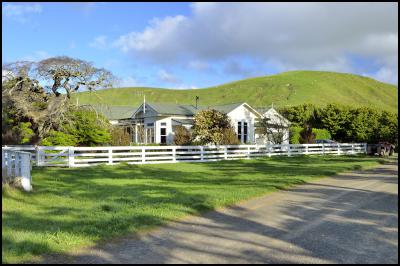Former Prime Minister’s family farm goes up for auction
Media Release
20.9.2016

Caption: The
Manawatu farm formerly owned by the only man to serve as
both New Zealand’s Prime minister and Governor General,
Sir Keith Holyoake, is on the market for
sale.
Former Prime Minister’s family farm goes up for auction
A highly-productive farm part paid for by a group of loyal National Party supporters to lure a future prime minister and governor general to live in their electorate has been place on the market for sale.
Kia Ora sheep and cattle farm some 18 kilometres from Dannevirke in Manawatu, was bought during World War II by Sir Keith Holyoake – the only person to have ever held the roles of both Prime Minister and Governor General of New Zealand, and the third longest-serving Prime Minister the country has ever had.
Sir Keith bought the 393 hectare Kia Ora Station for £11,874 in 1942 – with £3,000 of the purchase price coming from a ‘donation’ by the Dannevirke electorate branch of the National Party as an incentive package to tempt the young up-and-coming politician north from his then hop and tobacco farm near Motueka.
The family never actually resided at Kia Ora Station, preferring instead to live in Dannevirke. As a full-time politician, Sir Keith spent much of his week in Parliament in Wellington and only ever visited Kia Ora Station occasionally on weekends – where the silver-tongued orator gained a reputation for feeding out hay to the stock from the boot of his Daimler.
During a stellar political career, Sir Keith Holyoake served briefly as Prime Minister of New Zealand in 1957, before holding the role from 1960 – 1972 – the third longest term of any New Zealand Prime Minister. Sir Keith was appointed 13th Governor General of New Zealand in the term from 1977 – 1980.
During Sir Keith’s busy political career, the Dennevirke farm employed a full-time manager to run the sheep and beef operations, before son Roger Holyoake was appointed farm manager on Kia Ora Station in 1962. Sir Keith died in 1983, although the Dannevirke farm remained in his family’s control for a further 15 years.
For several years after Sir Keith’s death, a flat patch of the immaculately grassed farm was used for local cricket club matches. The Holyoake’s Kia Ora Station was sold in 1998 to its current owners, who also bought adjacent 159 hectare Manawa Farm a year later from separate vendors.
Now the combined Kia Ora and Manawa farms are being marketed for sale at auction on October 13 through Bayleys Hawke’s Bay. Salesperson Tony Rasmussen said the vendor’s preference was to sell both Kia Ora and Manawa as one block.
“However, depending on market feedback, if interest for the joint properties did not match the vendors’ pricing expectations but there was interest in one or other of the individual farms, the vendors would look at auctioning the two blocks separately on the same day,” Mr Rasmussen said.
Kia Ora Station has a large spring-feed catchment, Lake Rotoha, at the top of the property - providing a natural irrigation supply to large portions of the easy-medium contoured topography. Additional irrigation over the farm comes from Mangotoro Stream.
Infrastructure on the farm includes a substantially renovated 324 square metre five-bedroom villa, a 117 square metre three-bedroom manager’s residence, a four stand woolshed, a large stable complex, shearers quarters, sheep and cattle yards, hay barns and implement sheds. The property has its own airfield, and an 80-tonne fertiliser storage bin.
Kia Ora Station is divided into 45 main paddocks with a further three holding paddocks – all separated by conventional post and batten fencing. In recent years the farm has been used as a lamb finishing unit stocking some 20,000 lambs annually, with an additional smaller number of dairy grazers, steers, heifers and bulls, and up to 20 brood mares foaled.
Meanwhile, the smaller Manawa Farm has a reticulated water system, three-bedroom homestead, three stand woolshed, two hay barns, and stock yards. The property is divided into some 31 paddocks separated by post and batten fencing with some use of electric fencing.
“The two neighbouring units benefit from some 10 kilometres of front frontage onto a predominantly tar-sealed road. The council maintained vehicle and stock access greatly assists the efficiency of operations,” Mr Rasmussen said.
“The properties have previously been approved for dairy conversion but there are also numerous other land-used options which have been explored – from dairy goats and cropping through to continuing their long-running operation as a finishing unit,” Mr Rasmussen said.


 Trade Me Property: Auckland House Prices Hit Four-year Low, Dropping Below One Million
Trade Me Property: Auckland House Prices Hit Four-year Low, Dropping Below One Million AgResearch: New Funding For ‘Smart Ideas’ To Address Challenges For Primary Sector
AgResearch: New Funding For ‘Smart Ideas’ To Address Challenges For Primary Sector Forest and Bird: Hoiho Wins Bird Of The Year 2024
Forest and Bird: Hoiho Wins Bird Of The Year 2024 FIRST Union: Future Of 75 Jobs At Auckland Pulp Mill In The Balance
FIRST Union: Future Of 75 Jobs At Auckland Pulp Mill In The Balance Plant and Food Research: Government Funding For Developing Fish Products In The Lab
Plant and Food Research: Government Funding For Developing Fish Products In The Lab Ashburton Art Gallery: Crustacean Celebrities Of Aotearoa New Zealand On Display At Ashburton Art Gallery And Museum
Ashburton Art Gallery: Crustacean Celebrities Of Aotearoa New Zealand On Display At Ashburton Art Gallery And Museum



